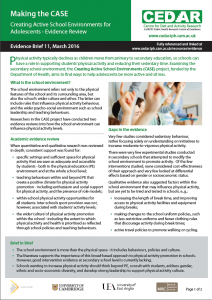Creating Active School Environments for Adolescents – Evidence Review – March 2016
Physical activity typically declines as children move from primary to secondary education, so schools can have a role in supporting students’ physical activity and reducing their sedentary time. Examining the secondary school environment, the Creating Active School Environments (CASE) project, funded by the Department of Health, aims to find ways to help adolescents be more active and sit less.
Jump to:
- What is the school environment?
- Academic evidence review
- Gaps in the evidence
- Non-academic evidence review
- Implications for school policies and interventions
- What next for CASE?
- References and resources
Brief in brief
- The school environment is more than the physical space – it includes behaviours, policies and culture.
- The literature supports the importance of this broad-based approach to physical activity promotion in schools. However, good intervention evidence at secondary school level is currently lacking.
- Schools wanting to increase physical activity should think beyond PE, consult with students, address gender, ethnic and socio-economic diversity, and develop strong leadership to support physical activity culture.
What is the school environment?
The school environment refers not only to the physical features of the school and its surrounding area, but also the school’s wider culture and ethos. The latter can include rules that influence physical activity behaviour, and the wider psycho-social environment such as school leadership and teaching behaviours.
Researchers in the CASE project have conducted two evidence reviews into how the school environment can influence physical activity levels.
Academic evidence review
When quantitative and qualitative research was reviewed in depth, consistent support was found for:
- specific settings and sufficient space for physical activity that are seen as adequate and accessible by students – both in the physical education (PE)
environment and at the whole school level; - teaching behaviours within and beyond PE that create a positive climate for physical activity promotion – including enthusiasm and social support for physical activity, and the presence of role models;
- within-school physical activity opportunities for all students. Inter-schools sport provision was not, however, associated with students’ activity levels;
- the wider ‘culture’ of physical activity promotion within the school – including the extent to which physical activity and health is prioritised as reflected through school policies and teaching behaviours.
- Read the full academic evidence review
Gaps in the evidence
Very few studies considered sedentary behaviour, rather focusing solely on understanding on initiatives to increase moderate-to-vigorous physical activity.
There were very few experimental studies conducted in secondary schools that attempted to modify the school environment to promote activity. Of the few interventions studied, none considered cost-effectiveness of their approach and very few looked at differential effects based on gender or socioeconomic status.
Qualitative evidence also suggested factors within the school environment that may influence physical activity, but are yet to be tried and tested in schools. e.g.:
- increasing the length of break time, and improving access to physical activity facilities and equipment during breaks;
- making changes to the school uniform policies, such as less restrictive uniforms and fewer clothing rules that discourage activity during break times;
- active travel policies to promote walking or cycling.
More innovative classroom-based approaches to increasing physical activity in the school environment are being developed and tested – such as standing desks, active lessons and activity breaks during class time.
However, the evidence is largely confined to primary school settings with younger children. The feasibility, acceptability and effectiveness of these strategies in secondary schools needs further exploration.
Non-academic literature review
CASE researchers reviewed UK-based non-academic literature relating to school-based initiatives and programmes that have attempted to modify the secondary school environment (including physical, social and policy features) in order to increase physical activity and/or reduce sedentary behaviours.
We also conducted telephone interviews with individuals from organisations involved in implementing initiatives. We found that
- Most initiatives targeting the secondary school environment have focused on extracurricular physical activity policies and PE based initiatives.
- Making successful changes to the wider school environment involved consulting with students and allowing them to design and lead initiatives.
- Changing the school culture is essential: making physical activity a priority and involving the whole school in planning and implementing initiatives. For
this to work effective leadership is key. - There are very limited examples of secondary schools that have made changes to their physical environment. Camden Active Spaces www.camden.gov.uk/activespaces is one exception.
- There are no interventions that have targeted the classroom environment through, for example active lessons or standing desks.
- Download the full review (pdf)
Implications for school policies and interventions
- It is likely that it is the combination and interaction of school-environment factors that influence adolescent physical activity, rather than a single characteristic of the school. Although adequate facilities and equipment are important for physical activity promotion, if the wider school policies do not encourage and support their use by all students, the overall impact on physical activity is likely to be limited.
- Schools should think beyond PE and sport provision and acknowledge the role of the wider school environment in influencing adolescents’ activity and sedentary behaviours.
- Schools should consult with students when making changes to the physical activity environment. Initiatives that are co-developed with students are likely to be more effective.
- School leadership is crucial for creating a culture of physical activity: prioritising physical activity and health, and making sure all school staff are involved in the implementation of policies and initiatives.
- School environment approaches to increase physical activity should have the potential to reach individuals irrespective of gender, athletic competence, disability and socioeconomic status.
What next for CASE?
This is the first in a series of Evidence Briefs from Creating Active School Environments for Adolescents (CASE). Researchers are currently (early 2016) engaging with key stakeholders (students, teachers, commissioners, academics) to help decide what school environment approaches to test in secondary schools later in the year.
- To keep up to date with CASE, visit www.mrc-epid.cam.ac.uk/research/studies/case/
References & resources
Research
- Morton KL et al (2015) The school environment and adolescent physical activity and sedentary behaviour: a mixed-studies systematic review. Obesity Reviews. http://onlinelibrary.wiley.com/doi/10.1111/obr.12352/abstract
- Morton KL (2015) The school environment and adolescent physical activity: An exploration of UK-based non-academic literature of interventions that promote physical activity via changes to the secondary school environment. www.mrc-epid.cam.ac.uk/wp-content/uploads/2024/06/CASE_UK-grey-literature-report.pdf
Policy & guidance
- Public Health England (2015) What works in schools and colleges to increase physical activity? www.gov.uk/government/publications/what-works-in-schools-to-increase-physical-activity-briefing
- Start Active Stay Active – A report on physical activity for health from the four home countries’ Chief Medical Officers. Department of Health, 2011. www.gov.uk/government/publications/start-active-stay-active-a-report-on-physical-activity-from-the-four-home-countries-chief-medical-officers
- How healthy behaviour supports children’s wellbeing. Public Health England, 2013 www.gov.uk/government/publications/how-healthy-behaviour-supports-childrens-wellbeing
Please cite this Evidence Brief as: UKCRC Centre for Diet and Activity Research (CEDAR), Evidence Brief 11 – Making the CASE – Creating Active School Environments for Adolescents – Evidence Review, March 2016. www.mrc-epid.cam.ac.uk/resources/policy-resources/evidence-briefs/eb-making-the-case/

 MRC Epidemiology Unit
MRC Epidemiology Unit
